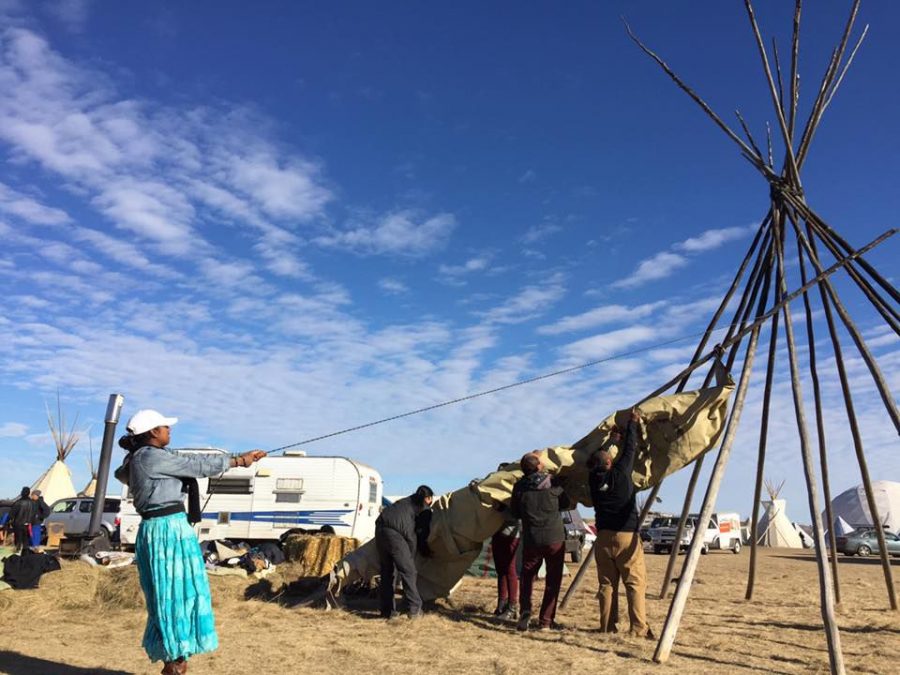Once more denied: Standing Rock dispersed
Jasmine S. LaBeau (blue dress), along with family and friends, restrike a teepee for the winter at the Standing Rock encampment.
March 1, 2017
Last week, on the shores of Cannon Ball River, unarmed protesters burned the remaining structures in what they called a ceremony of leaving, while police in riot gear descended upon them.
The Standing Rock protest against the Dakota Access Pipeline (DAPL) was the first time the seven Sioux tribes gathered together in the same place since the Battle of Little Bighorn and the fall of Gen. George Custer. Two events separated by a span of 140 years, and yet both outcomes tragically similar for the people of the Sioux nation: a short-lived victory.
So, what did the protest accomplish?
If the Standing Rock protests did anything, it showed that the United States, after hundreds of years of social progress, has no problem trampling over the indigenous population if it results in short-term benefits for corporate interest.
In December, the Army Corps of Engineers denied Energy Transfer Partners the ability to dig underneath the Missouri River, according to NPR. But President Donald Trump signed an executive order Jan. 24 continuing construction of the pipeline.
The Standing Rock Sioux Tribe still plans on fighting DAPL with a planned peaceful protest in Washington D.C. next month, as well as through the courts. I wish them godspeed, but, historically speaking, citing broken treaties does not do well in the United States judicial system.
With what has unfolded in the past 11 months, it is painfully obvious that the struggles of the Native American community’s search for cultural identity, tribal autonomy and livelihoods, within the borders of an often hostile government and an indifferent majority, are far from over.
The Standing Rock Sioux Tribe called for campers to vacate the Oceti Sakowin site located on the banks of Cannon Ball River in North Dakota, according to the tribe’s Facebook page. This makes Jan. 21 the official end to the formal protest of the Dakota Access Pipeline.
It is the end of a protest that saw thousands of people from around the world put their 21st-century lives on hold to travel to the Oceti Sakowin encampment and fight a 14th-century issue. By this point it’s old news, but the effects will be felt in the Native American community long after the last tipi on the shore of Cannon Ball River is burned.
So, in the end, who’s to blame?
Construction of the pipeline began during the presidency of Barack Obama. Trump perpetuated the status-quo of the United States’ indifference toward Native American struggles with the stroke of a pen. But this absolute disregard for the lives and voices of a historically brutalized people is not the product of the Trump administration, nor is it the fault of Obama. In the end, the continuous refusal to respect the culture, land and lives of the Native American people rests on our shoulders.
In October, near the height of the protest when the population of Oceti Sakowin was around 2,000, former Collegian photographer Phu Nguyen and I went to write a story about the people there.
On our last day, we met a man named Loves War. He invited us into his tipi and shared a cigarette and water.
He didn’t go to protests because he didn’t want to go to jail. He didn’t leave his tipi much, but he invited anyone in — something he learned from his mother. I asked him where he lived.
“They call my camp Rez Rock, because I’m Standing Rock Sioux,” Loves War said. “I live here. This is my home.”
And while DAPL is pumping millions of dollars into the pockets of Energy Transfer Partners, the shores of Cannon Ball River will be a reminder to the Standing Rock Sioux Tribe of another promise broken, another home stolen and another battle lost. But the war still continues.

























